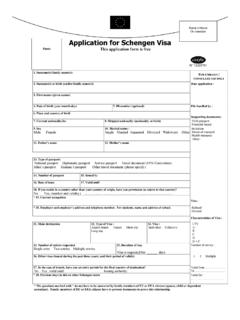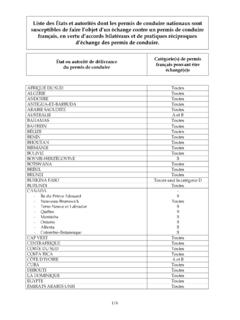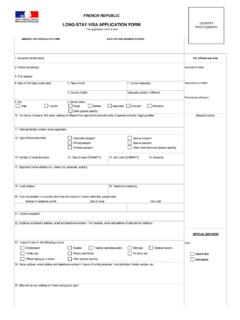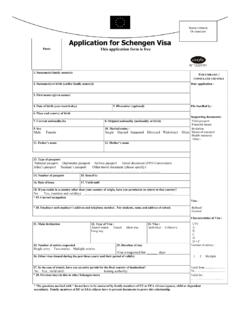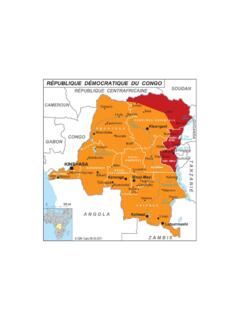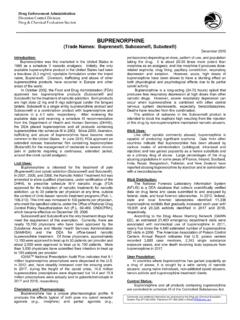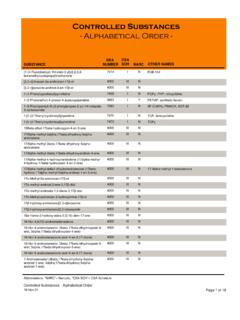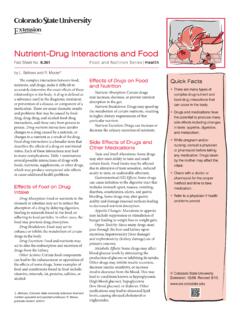Transcription of Narco-Terrorism: The Merger of the War on Drugs and the ...
1 Narco-Terrorism: The Merger of theWar on Drugs and the War on TerrorEmma Bjo rnehedThe aim of this article is to analyse the phenomena of narco-terrorism and the practicalmeasures utilised to counter this threat. By adopting the model of the crime-terrorcontinuum developed by Tamara Makarenko, the article will outline the similarities anddissimilarities of narcotics trafficking and terrorism in order to provide a more nuancedperspective on the concept of narco-terrorism. By doing so, the article will evaluate thekind of approach taken in combating the threat of : Narco-terrorism; Terrorism; narcotics trafficking; War on terror; War ondrugs; Crime-terror continuumIntroductionThe several decades long war on Drugs and the more recent war on terror havefound common ground in countering the threat of narco-terrorism, thus combiningtwo threats that have traditionally been treated separately.
2 The concept of narco-terrorism originates from an understanding that the two phenomena of narcoticstrafficking and terrorism are interconnected and subsequently that a coordination ofanti- drug and anti-terror policy can be used, and is necessary, to effectively deal withboth a link exists between the narcotics trade and terrorist organisations, as impliedin the term narco-terrorism, has been known to exist for decades, yet the internationalfocus on terrorism since 11 September 2001, has also increased the attention given tothe phenomenon of narco-terrorism [1]. Although, traditionally a concept connectedwith Latin America, in contemporary policy, narco-terrorism is increasingly linked tothe regions of Central and Southeast Asia, and specifically the narcotics -producingregions of the so-called Golden Crescent and the Golden 1744-0572 (print)/ISSN 1744-0580 (online)q2004 Taylor & FrancisDOI: Bjo rnehed is a researcher and project coordinator for the project on Terrorism and Conflict at the Programfor Contemporary Silk Road Studies at Uppsala University, CrimeVol.
3 6, No. 3&4, August November 2004, pp. 305 324 This article examines the concept of narco-terrorism in terms of the twophenomena it incorporates as well as the anti- drug and anti-terror measures that takesplace as a result of the coordination of policy in relation to narco-terrorism. The articlewill emphasise both similarities and dissimilarities between different kinds of narco-terrorist organisations and similarities and dissimilarities between counter narcoticsand counter terrorism efforts. This is done in order to analyse the Merger of the so-called war on Drugs and war on terror in an attempt to determine the usefulness ofcombating these two threats by adopting a unified policy approach. This articlerecognises the benefit and necessity of acknowledging the links between narcotic tradeorganisations and terrorist groups in law enforcement efforts.
4 However, it agues thatcaution be taken in assuming a one-front war on Drugs and terror under the umbrellaof the threat of narco-terrorism since this fails to account for the differences that alsoexists between Along a ContinuumNarco-terrorism is one of today s buzzwords in foreign and domestic policy. It shouldbe noted however, that even though the word is frequently used and serves as thefoundation of several policy decisions, its definition is ambiguous in that it hasdifferent focus and implications depending on what part of the composite word isemphasised. The term narco-terrorism was first used to describe campaigns by drugtraffickers using terrorist methods, such as the use of car bombs, assassinations andkidnappings, against anti- narcotics police in Colombia and Peru [2].
5 Narco-terroristsin this context refers to individuals such as the drug lord Pablo Escobar from theMedell n cartel in Colombia and other members of drug cartels, mafia or othercriminal organisations, whose actions were defined as the attempts of narcoticstraffickers to influence the policies of government by the systematic threat or use ofviolence [3]. According to this definition, the narcotic trafficking organisation servesas the referent object of analysis, with the illegal dealing of narcotics being the primeactivity and terrorist methods something which is sometimes resorted , focus can also be placed on the terrorism part of the composite wordnarco-terrorism. The United States drug Enforcement Agency (DEA) has covered thisaspect in a part of their definition of narco-terrorism which states narco-terrorismmay be characterized by the participation of groups or associated individuals intaxing, providing security for, or otherwise aiding or abetting drug traffickingendeavours in an effort to further, or fund, terrorist activities [4].
6 The DEA definitionbrings focus to terrorist organisations, highlighting the relatively recent attentiongiven to the fact that some terrorist organisations use narcotics trafficking for thepurpose of gaining revenue [5].This makes the definition of narco-terrorism almost dual in character, where theemphasis placed on the drug aspect or the terrorism aspect may vary might be argued that the difference in emphasis matters little since the concept ofnarco-terrorism can be seen as a middle-way convergence of two phenomena: drug306E. Bjo rnehedtrafficking and terrorism, with organisations doing a bit of both. This is however atbest partially should be noted that even with the acknowledgement of the duality of the term,narco-terrorism is a problematic concept and can be argued to complicate rather thanfacilitate discussions on the two concepts that it embodies.
7 With regard to terrorism,Weinberg et al argue that the concept of terrorism suffers from stretching and that itsattachment to other concepts such as cyber-terrorism and narco-terrorism runs therisk of adopting the term terrorism to a vast number of different concepts and therebydiffusing its definition [6]. There are also authors that seem to avoid using the termaltogether when discussing the convergence between criminal and terroristorganisations [7]. Despite, and arguable due to the ambiguities of narco-terrorism,as well as the frequent usage of the word, this article will use the term, narco-terrorismin its discussion. Thus hoping to make a modest contribution to a more nuancedperspective of the concept both with regard to the academic and policy order to acknowledge the ambiguity of the concept of narco-terrorism and toprovide the reader with a theoretical framework, this article wishes to draw upon thecrime-terror continuum model developed by Tamara Makarenko [8].
8 The modeldepicts organised crime and terrorist organisations existing on a continuum withorganised crime and terrorism situated at the far left and right respectively. In generalthe model illustrates the increased interaction between organised crime and terrorsince the 1990s and specifically accounts for four different forms of relationshipsbetween the two types of organisations: alliances, operational motivations,convergence and the black hole [9]. Hence organisations are placed on the crime-terror continuum with regard to the governing motivations of their acts and theenvironment in which they operate [10]. The crime-terror continuum model alsoaccounts for changing in motivation governing group action and subsequently and theposition of an organisation is fluid rather than fixed [11].
9 Such a move along thecontinuum by an organisation can be catalysed by a change in external or internalcircumstances. For example, a change in leadership, as in the case of Juma Namangani,the leader of the Islamic Movement of Uzbekistan (IMU), who is assumed to have beenkilled at Konduz following an air strike in November 2001 [12], can significantlychange the motivational factors of an organisation [13]. In this case the Namanganiadvocated ideological reasons for the use of violence yet after his death these were to alarge extent abandoned in favour of financial motivational factors. This then changedthe reasons for the IMU to engage in organised to Makarenko, the most common criminal activity that terroristorganisations are involved in is the international drug trade [14], thus althoughorganised crime may involve different criminal activity such as arms trade, humantrafficking, racketeering, by viewing the crime aspect of the continuum as solelynarcotics trade, the continuum can be used as a tool to view the concept of narco-terrorism.
10 Although the crime-terror continuum model fails to account for certainoccurrences, such as why there seem to be few, if any, organisations moving from morecriminal to the more political side of the spectrum, the model is here utilised for itsGlobal Crime307contribution to a clearer understanding and practical depiction of the interaction ofcrime and terrorism and as a theoretical complement to the ambiguous definition ofnarco-terrorism. This is because the phenomena can be found along the entirecontinuum, thus accounting for any of the two foci of the definitions, incorporatingorganisations such as Russian criminal gangs and al-Qaeda, which have fundamentallydifferent motivations and level of involvement in the different criminal activities, narcotics trade and terrorism.
